
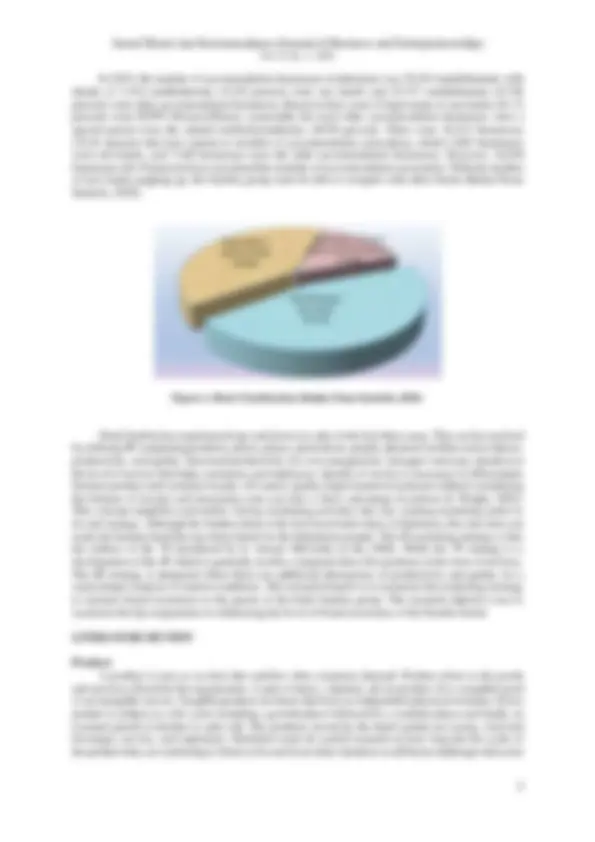
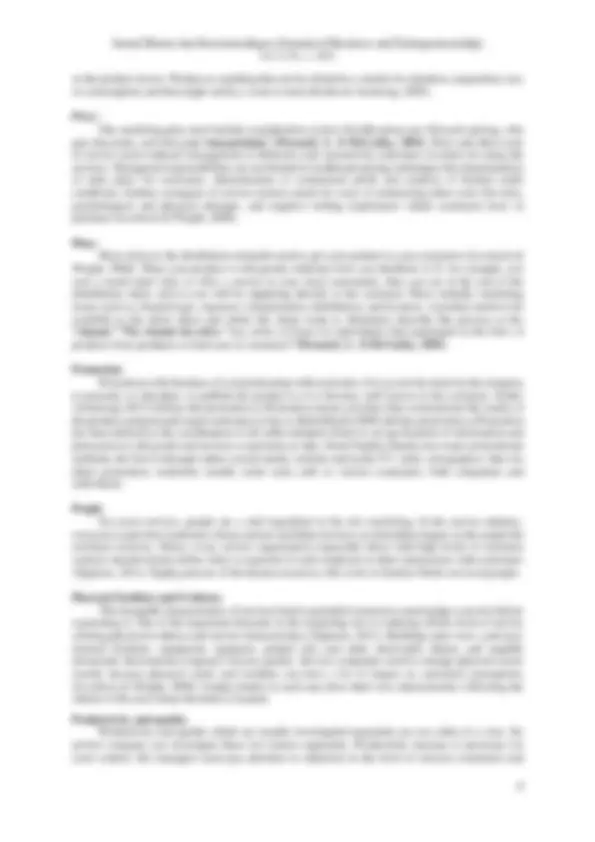
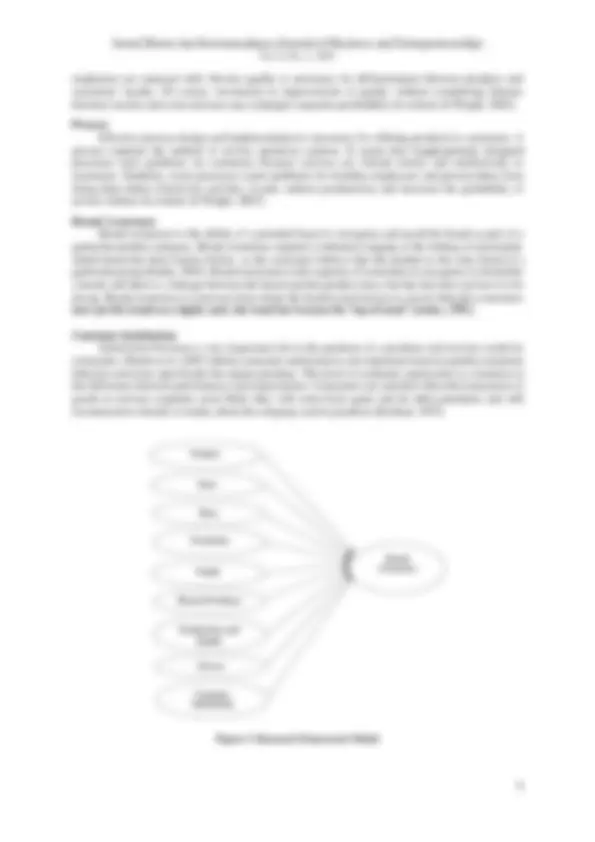
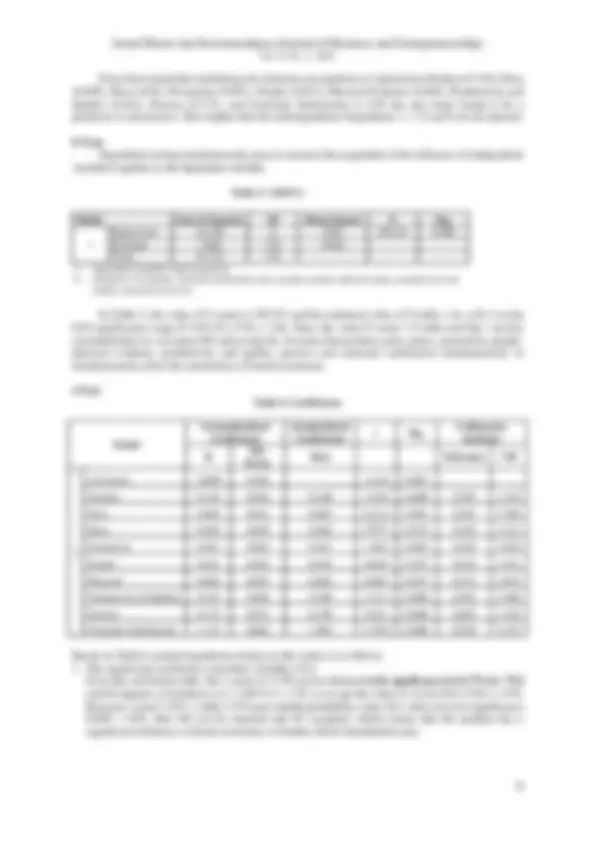
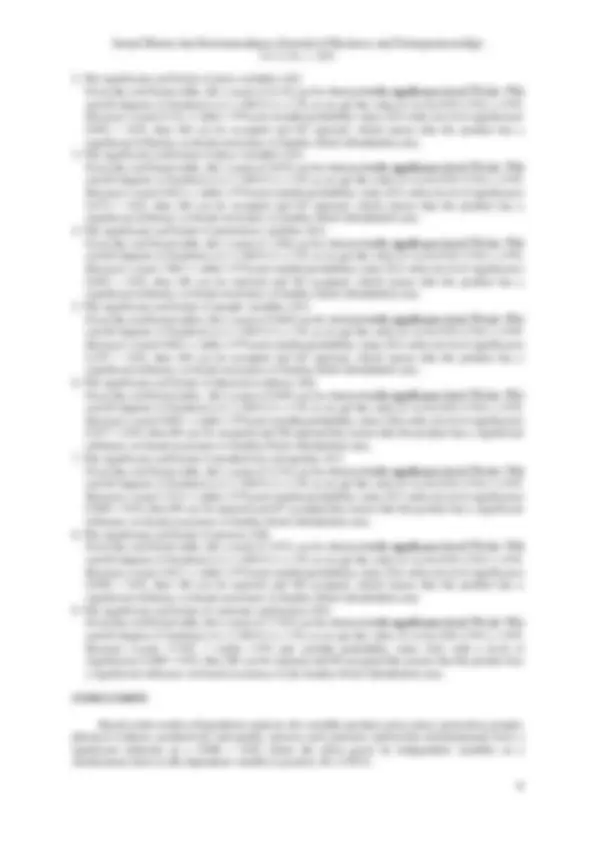
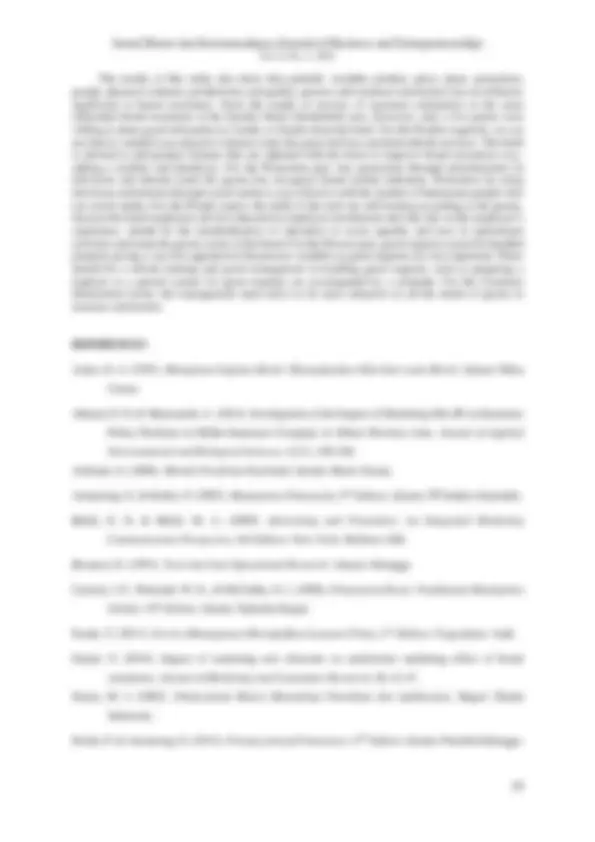


Study with the several resources on Docsity

Earn points by helping other students or get them with a premium plan


Prepare for your exams
Study with the several resources on Docsity

Earn points to download
Earn points by helping other students or get them with a premium plan
Community
Ask the community for help and clear up your study doubts
Discover the best universities in your country according to Docsity users
Free resources
Download our free guides on studying techniques, anxiety management strategies, and thesis advice from Docsity tutors
analyze the effect of Marketing Mix 8P (product, price, place, promotion, people, physical evidence, productivity and quality, process) and customer ...
Typology: Lecture notes
1 / 11

This page cannot be seen from the preview
Don't miss anything!







Vol. 9 , No. 1 , 202 1
Sofiani Universitas Bunda Mulia Original Research Received 24 December 2020 Revised 1 9 January 2021 Accepted 11 February 2021 Additional information at the end of the article Abstract: Higher brand awareness value and brand name can enhance its potential choosing by the customer. It also leads to higher loyalty and higher inclination of customers to pay more and higher purchase by the customer and lower firms' susceptibility in a competitive market. This study aimed to analyze the effect of Marketing Mix 8P (product, price, place, promotion, people, physical evidence, productivity and quality, process) and customer satisfaction for brand awareness in the Santika Hotel Jabodetabek. This study used primary data obtained from field research with Santika Hotel Jabodetabek customers and secondary data. To collect and analyze data, statistical regression analysis was used to determine patterns of relationships that reveal independent variables' influence on the dependent variable. Based on the regression analysis results, the product, price, place, promotion, people, physical evidence, productivity and quality, process, and customer satisfaction simultaneously have a significant impact on brand awareness. Based on the results of hypothesis analysis and testing of field data, simultaneously product, price, place, promotion, people, physical evidence, productivity and quality, process and customer satisfaction have a significant influence on brand awareness where the effect given by independent variables to the dependent variable is positive. Keywords: marketing mix; customer satisfaction; brand awareness Abstrak: Nilai kesadaran merek dan nama merek yang lebih tinggi dapat meningkatkan potensi pemilihan oleh pelanggan dan juga mengarah pada loyalitas yang lebih tinggi dan kecenderungan yang lebih tinggi dari pelanggan untuk membayar lebih banyak pembelian oleh pelanggan serta kerentanan perusahaan yang lebih rendah dalam persaingan pasar. Penelitian ini bertujuan untuk menganalisis pengaruh Bauran Pemasaran 8P (produk, harga, tempat, promosi, orang, bukti fisik, produktivitas dan kualitas, serta proses) dan kepuasan pelanggan terhadap brand awareness di kawasan Santika Hotel Jabodetabek. Penelitian ini menggunakan data primer yang diperoleh dari penelitian lapangan dengan pelanggan Hotel Santika Jabodetabek dan data sekunder. Untuk mengumpulkan dan menganalisis data, analisis regresi statistik digunakan untuk mengetahui pola hubungan yang mengungkapkan pengaruh variabel independen terhadap variabel dependen. Berdasarkan hasil analisis regresi menunjukkan produk, harga, tempat, promosi, orang, bukti fisik, produktivitas dan kualitas, proses dan kepuasan pelanggan secara simultan berpengaruh signifikan terhadap kesadaran merek. Berdasarkan hasil analisis hipotesis dan pengujian data lapangan, secara simultan produk, harga, tempat, promosi, orang, bukti fisik, produktivitas dan kualitas, proses dan kepuasan pelanggan berpengaruh signifikan terhadap kesadaran merek dimana pengaruh yang diberikan oleh variabel bebas terhadap variabel dependennya positif. Kata Kunci: bauran pemasaran; kepuasan pelanggan; kesadaran merek
Vol. 9 , No. 1 , 202 1 INTRODUCTION Competitor in the tourism industry increases, while more choice of product or services is given to the consumers. They tend to be more selective in choosing the products or services to gain more benefits. In today's highly competitive markets, keeping customers and retaining their loyalty is considered crucial in maintaining business. In 2019, most of star hotels were 3-star hotel, namely 1,373 establishments (39.05 percent) with 125,149 rooms (34.41 percent), followed by 2- star hotel namely 802 establishments (22.81 percent) with 56,107 rooms (15.42 percent). The third biggest one was a 4 - star hotel with as much as 724 establishments (20.59 percent) and 117 ,744 rooms (32.37 percent) (Badan Pusat Statistik, 2020). Figure 1. Hotel Growth in Indonesia (Badan Pusat Statistik, 2020) Kompas Gramedia is one of the largest print media companies in Indonesia since 1965. Not satisfied just with the business of print media, Kompas Gramedia develop companies ranging from printing office in Indonesia, Gramedia Bookstore, Publishing Company, Radio Company (Sonora), Television (Kompas TV and Trans7), Education (Universitas Multi Media Nusantara, ELTI), and Manufacturing (Tessa). In 1978, the pioneer of Kompas Gramedia began to think about diversification outside of the main business. One result is the formation of a company engaged in the field of hospitality. Then, on August 22, 1981, they formed PT GRAHAWITA SANTIKA. Hotel Soeti is the first hotel purchased by PT Grahawita Santika in 1981. The hotel is in a very strategic location in the city. Graha Wita Santika group has various types of hotels ranging from 2-star to the name of Amaris, 3 - star hotel named Santika, 4-star Santika Premier hotel, 5-star royal collection the Anvaya, the Kayana, and the Samaya. Until 2017, Kompas Gramedia group has built 103 local hotel chains in Indonesia, including the Santika hotels in Jakarta, Bogor, Depok, Tangerang, Bekasi (Jabodetabek) area. Table 1. List Hotel Santika Jabodetabek Area HOTEL LOCATION TOTAL ROOM ADVANTAGES Santika Taman Mini JAKARTA 124 Close to attractions Santika Kelapa Gading JAKARTA 151 Close to the mall Santika Bogor BOGOR 143 Close to attractions Santika Depok DEPOK 122 Close to the mall Santika BSD City Serpong TANGERANG 150 Close to the mall Santika Cikarang BEKASI 120 Close to the mall
Vol. 9 , No. 1 , 202 1 as the product moves. Product as anything that can be offered to a market for attention, acquisition, use, or consumption and that might satisfy a want or need (Kotler & Amstrong, 2005). Price The marketing plan must include consideration on how flexible prices are, lifecycle pricing, who gets discounts, and who pays transportation” (Perreault, Jr. & McCarthy, 2004). Price and other costs of service sector indicate management of different costs incurred by customers in return for using the services. Managerial responsibilities are not limited to traditional pricing techniques like determination of sales price for customers, determination of commercial profit and creation of limited credit conditions. Further, managers of service section search for ways of minimizing other costs like time, psychological and physical attempts, and negative feeling experiences which customers have in purchase (Lovelock & Wright, 2000). Place Place refers to the distribution channels used to get your product to your customers (Lovelock & Wright, 2000). What your product is will greatly influence how you distribute it. If, for example, you own a small retail store or offer a service to your local community, then you are at the end of the distribution chain, and so you will be supplying directly to the customer. Place includes marketing issues such as, channel type, exposure, transportation, distribution, and location. A product needs to be available to the client when and where the client wants it. Marketers describe this process as the “channel.” The channel describes “any series of firms (or individuals) that participate in the flow of products from producer to final user or consumer” (Perreault, Jr. & McCarthy, 2004). Promotion Promotion is the business of communicating with customers. It is an activity done by the company to promote, to introduce, to publish the product so it is become well known to the customer. Kotler Armstrong (2013) defines the promotion as Promotion means activities that communicate the merits of the product and persuade target customers to buy it. Belch Belch (2009) defines promotion as Promotion has been defined as the coordination of all seller-initiated efforts to set up channels of information and persuasion to sell goods and services or promote an idea. Hotel Santika Depok uses many promotional methods, the first is through online (social media, website and media TV, radio, newspapers). then for direct promotion, marketers usually make sales calls to various consumers, both companies and individuals. People For most services, people are a vital ingredient in the mix marketing. In the service industry, everyone is part time marketers whose actions and behavior have an immediate impact at the output the customer receives. Hence, every service organization (especially those with high levels of customer contact) should clearly define what is expected of each employee in their interactions with customers (Tjiptono, 2011). Eighty percent of the human resources who work in Santika Hotels are local people. Physical Facilities and Evidence The intangible characteristics of services lead to potential customers cannot judge a service before consuming it. One of the important elements in the marketing mix is reducing efforts level of risk by offering physical evidence and service characteristics (Tjiptono, 2011). Building outer view, yard area, internal furniture, equipment, signposts, printed info and other observable objects and tangible documents demonstrate company's service quality. Service companies need to manage physical assets exactly because physical assets and facilities can have a lot of impact on customer's perceptions (Lovelock & Wright, 2000). Santika hotels in each area have their own characteristics following the culture of the area where the hotel is located. Productivity and quality Productivity and quality which are usually investigated separately are two sides of a coin. No service company can investigate these two factors separately. Productivity increase is necessary for costs control, but managers must pay attention to reduction in the level of services customers and
Vol. 9 , No. 1 , 202 1 employees are annoyed with. Service quality is necessary for differentiation between products and customers' loyalty. Of course, investment in improvement of quality without considering balance between income and costs increase may endanger corporate profitability (Lovelock & Wright, 2002). Process Effective process design and implementation is necessary for offering products to customers. A process explains the method of service operation systems. It seems that inappropriately designed processes raise problems for customers because services are offered slowly and ineffectively to customers. Similarly, weak processes create problems for frontline employees and prevent them from doing their duties effectively and this, in part, reduces productivity and increases the probability of service failures (Lovelock & Wright, 2002). Brand Awareness Brand awareness is the ability of a potential buyer to recognize and recall the brand as part of a particular product category. Brand awareness requires continuum ranging of the feeling of uncertainty which brand has been known before, so the customers believe that the product is the only brand in a particular group (Kotler, 2003). Brand awareness is the capacity of consumers to recognise or remember a brand, and there is a linkage between the brand and the product class, but the link does not have to be strong. Brand awareness is a process from where the brand is just known to a level when the consumers have put the brand on a higher rank; the brand has become the “top of mind” (Aaker, 1991). Customer Satisfaction Satisfaction becomes a very important role in the purchase of a products and services made by consumers. Martin et al. (2007) define consumer satisfaction is one important factor to predict consumer behavior and more specifically the repeat purchase. The level of consumer satisfaction is a function of the difference between performance and expectations. Consumers are satisfied when the transaction of goods or services acquired, most likely they will come back again and do other purchases and will recommend to friends or family about the company and its products (Richard, 1993). Figure 3. Research Framework Model
Vol. 9 , No. 1 , 202 1 From Table 3, it is shown that female respondents are 108 respondents, while male respondents are 72 respondents. Therefore, the female respondents are higher than the male respondents. Data Collection Procedurs The primary source is the data source that directly provide data to data collectors” (Sugiyono, 2008 ). The primary sources of this form of notes of interviews were obtained through interviews conducted by the author. In addition, the authors also conducted field observations, collect data in the form of a note about the situation and events in the library, and then distributing questionnaires to be filled out by respondents. (Arikunto 2006). Questionnaire is a written statement that is used to obtain information from respondents in terms of reporting about the person or the things that he knew. (Sugiyono, 2008 ). Questionnaire is a technique of data collection is done by giving a set of questions or a written statement to the respondent to answer. The questionnaire was distributed online over a 4- week collection period using the google form media. Research Instrument The research structure has been marketing mix and customer satisfaction is the independent variable, and brand awareness is dependent variable. The current study measures brand awareness by asking whether customers know the brand and tests the following hypothesis. It is a tool used to determine the regression equation that shows the influence between two or more independent variables with the dependent variable. The goal is to predict the value of the dependent variable when the independent variable value increased or decreased, and to determine the direction of the relationship between the independent variables and the dependent variable is whether each - each variable associated positive or negative (Hasan, 2002). Regression linier: Y= a+ b1X1+b2X2+b3X3+b4X4+b5X5+b6X6+b7X7+b8X8+e Y = Brand Awareness a = Constanta b1 = Coefficient Product X1 = Product (Independent variable) b2 = Coefficient Price X2 = Price (Independent variable) b3 = Coefficient Place X3 = Place (Independent variable) b4 = Coefficient Promotion X4 = Promotion (Independent variable) b5 = Coefficient People X5 = People (Independent variable) b6 = Coefficient Physical Evidence X6 = Physical Evidence (Independent variable) b7 = Coefficient Productivity and Quality X7 = Productivity and Quality (Independent variable) b8 = Coefficient Process X8 = Process (Independent variable) RESULTS AND DISCUSSION Regression Analysis The determinant test shows that the value of the adjusted R² is 0,845, which shows that 8P and Customer satisfaction react to 84 .5% to Brand Awareness, while the rest is 15.5% react to the other variable that is not examined (see Table 4). The study uses linear regression analysis to examine the relationship between marketing mix, and satisfaction for brand awareness. Table 4. Model Summary Model R R Square Adjusted R Square Std. Error of the Estimate Durbin-Watson 1 0. 923 0. 853 0. 845 0. 21513 1. 463 a. Predictors: (Constant), customer satisfaction, price, people, product, physical, place, productivity and quality, promotion, process. b. Dependent Variable: brand awareness
Vol. 9 , No. 1 , 202 1 It has been found that marketing mix elements are predictor of satisfaction Product (0.194), Price (0.005), Place (0.02), Promotion ( 0 .051), People (0.021), Physical Evidence (0.003), Productivity and Quality ( 0 .242), Process (0.175), and Customer Satisfaction (1.119) has also been found to be a predictor of satisfaction. This implies that the null hypotheses Hypotheses 1, 7, 8 and 9 are all rejected. F-Test Hypothesis testing simultaneously aims to measure the magnitude of the influence of independent variables together to the dependent variable. Table 5. ANOVA Model Sum of Squares Df Mean Square F Sig. 1 Regression 45. 548 9 5. 061 109. 351 0. 000 Residual 7. 868 170 0. 046 Total 53. 415 179 a. Dependent Variable: brand awareness b. Predictors: (Constant), customer satisfaction, price, people, product, physical, place, productivity and quality, promotion, process. In Table 5, the value of F-count is 109 .351 and the statistical value of F-table = (k; n-K-1) at the 0.05 significance stage (F 0.05 (9) (170) = 1.96. Since the value F-count > F-table and Sig < ά, it is concluded that we can reject H 0 and accept Ha. It means that product, price, place, promotion, people, physical evidence, productivity and quality, process and customer satisfaction simultaneously or simultaneously affect the satisfaction of brand awareness. t-Test Table 6. Coefficients Model Unstandardized Coefficients Standardized Coefficients t Sig. Collinearity Statistics B Std. Error Beta Tolerance VIF 1 (Constant) - 0. 689 0. 202 3. 410 0. 001 Product 0. 194 0. 036 0. 188 5. 359 0 .000 0. 705 1. 419 Price 0. 005 0. 041 0. 007 0. 124 0. 901 0. 294 3. 398 Place 0. 002 0. 049 0. 002 0.^032 0. 975 0. 320 3. 127 Promotion 0. 051 0. 062 0. 031 1. 984 0. 003 0. 258 3. 870 People 0. 021 0. 025 0. 035 0. 849 0. 397 0. 518 1. 931 Physical 0. 003 0. 035 0. 004 0. 092 0. 927 0. 374 2. 675 Productivity & Quality 0. 242 0. 046 0. 288 5. 314 0 .000 0. 295 3. 386 Process 0. 175 0. 031 0. 199 5. 631 0 .000 0. 695 1. 439 Customer Satisfaction 1. 119 0. 062 1. 083 17. 952 0 .000 0. 238 4. 197 Based on Table 6, partial hypothesis testing on this study is as follows:
Vol. 9 , No. 1 , 202 1 The results of this study also show that partially variables product, price, place, promotion, people, physical evidence, productivity and quality, process and customer satisfaction. has an influence significant to brand awareness. From the results of surveys of customer satisfaction to the most influential brand awareness at the Santika Hotel Jabodetabek area. However, only a few guests were willing to share good information to family or friends about the hotel. For the Product segment, we can see that in variable Less attractive features make the guest feel less satisfied with the services. The hotel is advised to add product features that are adjusted with the times to improve brand awareness (e.g., adding a minibar and hairdryer). For the Promotion part, less promotion through advertisement on television and internet make the guests less recognize brand santika indonesia. Promotion by using television and internet through social media is very effective with the number of Indonesian people who use social media. For the People aspect, the skills of the staff are still lacking according to the guests, because the hotel employees are less educated in employee recruitment and only rely on the employee’s experience. should be the standardization of education to occur equality and ease in operational activities and make the guests aware of the brand. For the Process part, guest requests cannot be handled properly giving a very less appraisal of the process variables as guest requests are very important. There should be a refresh training and good management in handling guest requests. such as preparing a logbook or a special system for guest requests are accompanied by a reminder. For the Customer Satisfaction factor, the management must strive to be more attractive in all the needs of guests to increase satisfaction. REFERENCES Aaker, D. A. (1991). Manajemen Equitas Merek: Memanfaatkan Nilai dari suatu Merek. Jakarta: Mitra Utama. Ahmad, G. D. & Mansoureh, A. (2014). Investigation of the Impact of Marketing Mix 8P on Insurance Policy Purchase in Mellat Insurance Company in Alborz Province, Iran. Journal of Applied Environmental and Biological Sciences, 4(11), 100 - 106. Arikunto, S. (2006). Metode Penelitian Kualitatif. Jakarta: Bumi Aksara. Armstrong, G. & Kotler, P. (2003). Manajemen Pemasaran , 9 th^ Edition. Jakarta: PT Indeks Gramedia. Belch, G. E. & Belch, M. A. (2009). Advertising and Promotion: An Integrated Marketing Communication Perspective, 8th Edition. New York: McGraw-Hill. Bronson, R. (1993). Teori dan Soal Operational Research. Jakarta: Erlangga. Cannon, J. P., Perreault, W. D., & McCarthy, E. J. (2008). Pemasaran Dasar: Pendekatan Manajemen Global, 16th^ Edition. Jakarta: Salemba Empat. Fandy, T. (2011). Service Management Mewujudkan Layanan Prima, 2nd^ Edition. Yogyakarta: Andi. Harjot, S. (2016). Impact of marketing mix elements on satisfaction mediating effect of brand awareness. Journal of Marketing and Counsumer Research , 20 , 41 - 47. Hasan, M. I. (2002). Pokok-pokok Materi Metodologi Penelitian dan Aplikasinya. Bogor: Ghalia Indonesia. Kotler, P. & Armstrong, G. (2013). Prinsip-prinsip Pemasaran, 12 th^ Edition. Jakarta: Penerbit Erlangga.
Vol. 9 , No. 1 , 202 1 Lovelock, C. & Lauren, W. (2002). Principle of Service Marketing and Management, 2 nd^ Edition. New Jersey: Pearson Education International, Inc. Morrison, G. (2012). Dasar-dasar Pendidikan Anak Usia Dini. Jakarta: Permata Puri Media Kembangan Utara. Sugiyono (2008). Metode Penelitian Bisnis. Bandung: Alfabeta. Article correspondence should be sent to: Sofiani, Universitas Bunda Mulia (sofiani@bundamulia.ac.id) Recommended Citation: Sofiani (202 1 ). Analysis of Marketing Mix (8P) and Customer Satisfaction for Brand Awareness in Santika Hotel Jabodetabek Area. Journal of Business and Entrepreneurship, 9 ( 1 ), 1 - 11. This article is available online at: http://ojs.sampoernauniversity.ac.id (ISSN: 2302- 411 9 Print, 2685-6255 Online)